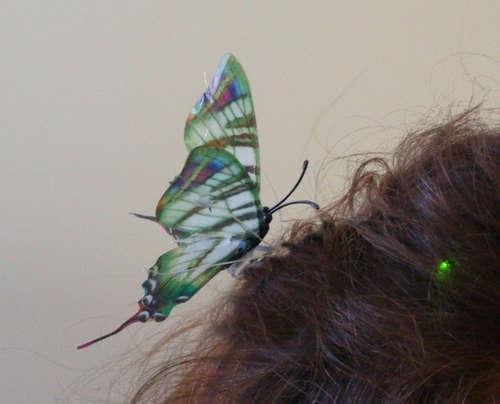Animatronic Butterfly Completes Wedding Day Look
User fiveMarch on Instructables was asked by a friend to design a moving butterfly that she could wear as a hair clip on her wedding day.
August 4, 2011
Recently seen on Instructables: an animatronic butterfly suitable to wear by a bride at her wedding. User "fiveMarch" on Instructables was asked by a friend to design a moving butterfly that she could wear as a hair clip on her wedding day. Who could turn down a request like that?
FiveMarch assembled the components: a hairclip, AAA battery pack, AT microcontroller, and a little bitty servo. Fortunately, the bride has enough hair that all of those things can be hidden in it and only the butterfly is visible (as well as a green LED -- not sure why that is on there). The circuit also includes a photoresistor, so the butterfly can flap its wings in response to changing light conditions.

Source: Instructables.com
I think this is a neat project, although there must be a pretty small subset of potential brides who would be interested in this. How could it be improved? Mostly by making the non-butterfly portion of the thing smaller.
Some commenters suggested memory wire in place of the servo. Memory wire, or shape memory alloy, has one shape at room temperature and takes on a different shape when heated or cooled. In this application the heat would have to be supplied by electrical current. You can find the electrical and mechanical properties of the material online. I will leave it as an exercise to the reader as to whether the thinnest available wire would present too much current draw for a small battery.
The battery is another area for improvement. The author considered a rechargeable lithium-ion battery but ended up using a 2-cell AAA battery pack. A better choice would have been a Lithium coin cell. With capacities up to 1000mAh, the larger ones would outlast the AAA battery pack while being much smaller.
I wonder if one couldn’t build a smaller actuator. The servo chosen almost certainly provides more force than necessary, and unneeded positioning precision. A simple hand-wound solenoid might work as well and would be simpler to drive and consume less power.
Finally, some projects call for overkill, and some call for simplicity. To me this one needs simple elegance, and I think it would be better to replace the microcontroller with a simple circuit using op-amps or 555 timers to trigger the movements.
In the end, however, hats off to fiveMarch for undertaking the task and delivering well in advance for this high-pressure and non-slippable deadline.
The editors of Design News have handpicked your favorite Gadget Freak cases from over the years, bringing them together in a dynamic digital edition, complete with videos, which you can view here!
You May Also Like

.jpg?width=300&auto=webp&quality=80&disable=upscale)

